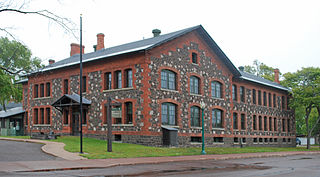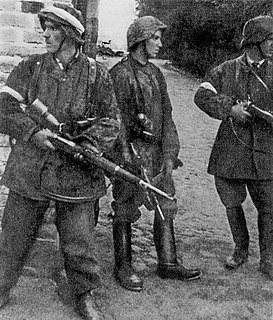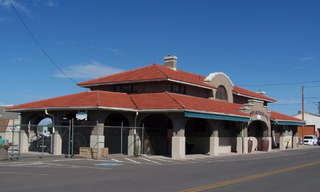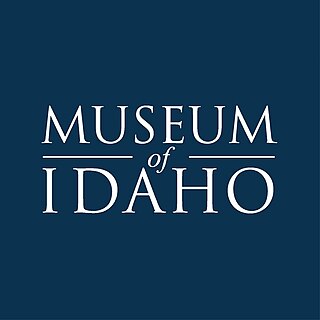
Lake Odessa is a village in Ionia County of the U.S. state of Michigan. The population was 2,018 at the 2010 census. It is located in the southern portion of the county in Odessa Township on the northeast shore of Jordan Lake, which is the boundary with Barry County.

The California State Railroad Museum is a museum in the state park system of California, United States, interpreting the role of the "iron horse" in connecting California to the rest of the nation. It is located in Old Sacramento State Historic Park at 111 I Street, Sacramento.

The Reynolds-Alberta Museum is a agricultural, industrial, and transportation museum in Wetaskiwin, Alberta, Canada. The museum is situated on an 89-hectare (220-acre) property containing the main museum building, an aviation display hangar, and its storage facility. The museum's aviation display hangar also houses Canada's Aviation Hall of Fame.

Keweenaw National Historical Park is a unit of the U.S. National Park Service. Established in 1992, the park celebrates the life and history of the Keweenaw Peninsula in the Upper Peninsula of the U.S. state of Michigan. As of 2009, it is a partly privatized park made up of two primary units, the Calumet Unit and the Quincy Unit, and 21 cooperating "Heritage Sites" located on federal, state, and privately owned land in and around the Keweenaw Peninsula. The National Park Service owns approximately 1,700 acres (690 ha) in the Calumet and Quincy Units. Units are located in Baraga, Houghton, Keweenaw, and Ontonagon counties.

White Pine Village is an outdoor museum in Ludington, Michigan, containing nineteenth-century buildings and related historical items. The thirty buildings in the village contain artifacts relating to pioneer lumbering, music, farming, shipping, sports, and businesses. Occasionally performances are done on blacksmithing, spinning, leatherworking, candlemaking, wood carving, and basket making. The museum's centerpiece is an 1849 farmhouse.

Two Harbors station is a historic train station located on Sixth Street in Two Harbors, Minnesota. The station was built in 1907. The large two-story depot was the third depot on the site. The Minnesota Iron Company developed the Duluth and Iron Range Railroad in 1883, laid out the town of Two Harbors in 1885, and built depots to conducts its business. When the rail line was completed to Duluth, it was used as a transfer point for passengers, lumber, and mining supplies. When passenger service ended in 1961, the depot was donated to Lake County. The building was listed on the National Register of Historic Places in 1983 as the Duluth and Iron Range Railroad Company Depot.

Collier Memorial State Park is a state park in southern Oregon. The park is operated and maintained by the Oregon Parks and Recreation Department. It is located on U.S. Highway 97, approximately 30 miles (48 km) north of Klamath Falls and 105 miles (169 km) south of Bend. The park covers 146 acres (59 ha) along the Williamson River.

The St. Louis County Depot is a historic train station in Duluth, Minnesota, United States. It was built as a union station in 1892, serving seven railroads at its peak. Rail service ceased in 1969 and the building was threatened with demolition until it reopened in 1973 as The Depot St. Louis County Heritage & Arts Center. Train service also resumed from 1974 to 1985, by Amtrak.

The Polish Home Army Museum in Orchard Lake, Michigan is dedicated to the memory of the brave men and women of the Armia Krajowa during World War II. The Museum tells the story of the struggle for the freedom and independence of Poland during World War II. On September 1, 1939, without declaring war, the Nazi German Army, Navy, and Air Forces invaded Poland from the north, west and south. Sixteen days later, on September 17, the Soviet Union also attacked Poland from the east. For Europe, the Nazi invasion of Poland marked the beginning of World War II; for Poland, the Soviet invasion also marked the beginning of a 50-year struggle against communism.
The Pushmataha County Historical Society is a historical society devoted to collecting and preserving the history of Pushmataha County, Oklahoma. It is headquartered in the historic Frisco Depot in Antlers, Oklahoma, which it operates as a public museum.

The Mille Lacs Indian Museum and Trading Post is a museum dedicated to the Mille Lacs Band of Ojibwe's history, culture, and contemporary life. It officially opened to the public on May 18, 1996. Located in Onamia, Minnesota, United States, it is one of the 26 historical sites and museums run by the Minnesota Historical Society.

The Elkhorn City Railroad Museum is a railroad museum located in Elkhorn City, Kentucky. The museum was established in 1990 and is dedicated to educating the public on the history of railroads in Kentucky's Eastern Mountain Coal Fields region.

The Brooksville 1885 Train Depot is one of three museums operated by the Hernando Historical Museum Association.(1) The museum is located just south of downtown Brooksville, Florida on Russell Street. It was originally built by the Florida Southern Railway. The museum is dedicated to the railroad, and local history of Brooksville, Hernando County, and Florida.
Clay County Historical Society Museum is a local history museum in a historic building in Liberty, Missouri. The museum building dates to 1865. It was a drug store and a doctor's office until 1963, when it was turned into a museum.

Oceana County Historical & Genealogical Society is a historical society representing the local history of Oceana County, Michigan. Its Research Headquarters and Library are located in Hart, Michigan. The organization runs Historical Park Museums located in Mears, Michigan, about 4 miles away.

The Montrose County Historical Museum is located in Montrose, Colorado, USA, founded in 1973 by the Montrose County Historical Society. The society's mission is to preserve, display and interpret the historic and cultural legacy of Montrose County and its surrounding region. Its building, the Denver and Rio Grande Depot, is listed on the National Register of Historic Places.

Conneaut is a former New York Central train station in the U.S. town of Conneaut, Ohio. It was built in 1900 by the Lake Shore and Michigan Southern as a replacement for an older wooden depot, then acquired by the New York Central Railroad in 1914, along with the rest of the LS&MS. The passenger depot building has housed the Conneaut Historical Railroad Museum since 1964, and has a display track with the Nickel Plate Road #755 Berkshire steam engine. The station has been registered as the Lake Shore And Michigan Southern Passenger Depot on the National Register of Historic Places since March 27, 1975. The freight house connected to the station is operated by the Conneaut Area Historical Society.

The Jeffersontown Historical Museum is a neighborhood history museum in Jeffersontown, Kentucky. It details the history of Jeffersontown as it progressed from a small rural community with a town square to the city that it is today.

The Museum of Idaho (MOI) is a history and science museum in downtown Idaho Falls, Idaho. The museum features exhibits, collections, and programs focused on the social and environmental history of Idaho and the Intermountain West, as well as prominent traveling exhibits on a variety of subjects. Its tagline is “bringing the world to Idaho, and Idaho to the world”.


















